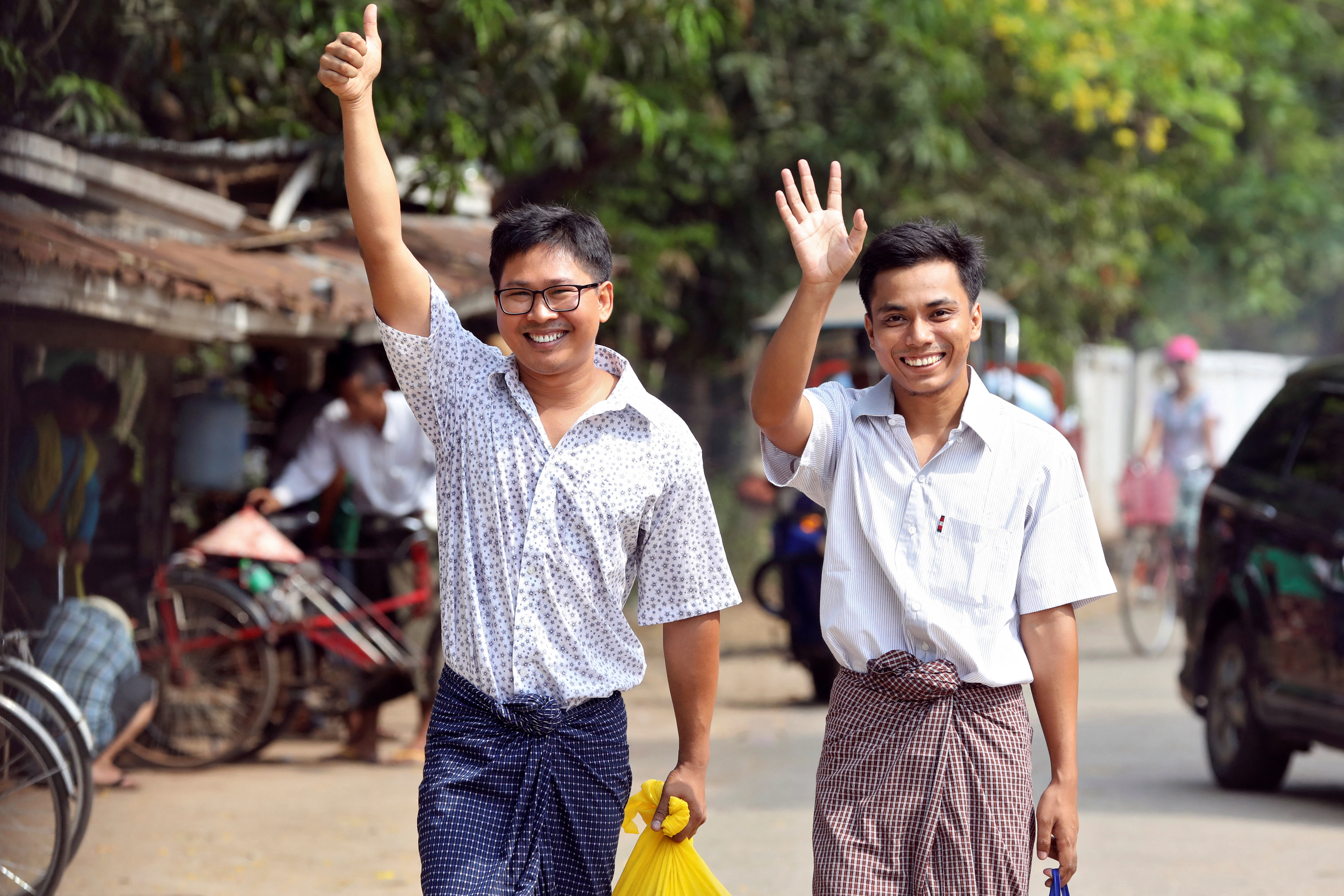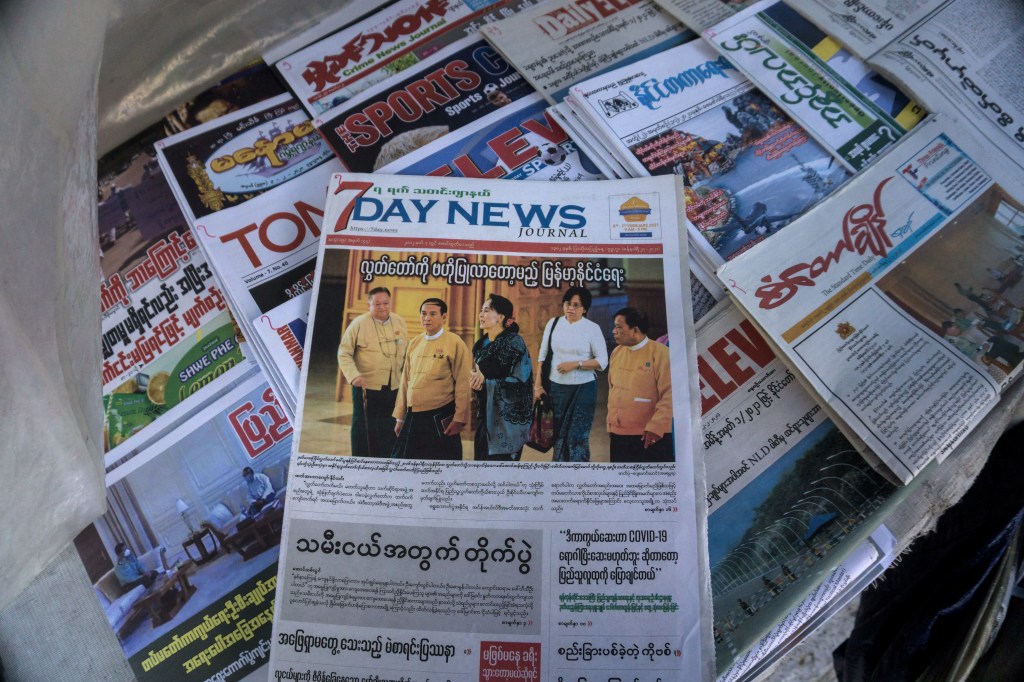On Jan. 29, investigative news outlet Myanmar Now published an article about a “huge political storm” brewing in the country’s capital. It posited a nightmare scenario: that the military was planning to arrest senior government officials, including civilian leader Aung San Suu Kyi, crushing a decade of democratic reforms and plunging the country back into junta rule.
After it went live, Myanmar Now staff evacuated the office.
Videos by VICE
“As soon as we published that story, we stopped using the newsroom,” editor Swe Win told VICE World News.
The grim prediction came true, and the military seized power days later in the early hours of Feb. 1. Immediately after, a nationwide resistance movement rose up, and armed forces responded with characteristic violence, killing hundreds and arresting thousands of peaceful protesters.
The junta is also targeting the media. In March, authorities revoked the licenses of five local outlets—including Myanmar Now— although most are still carrying on from secure locations. Police have arrested dozens of reporters, including Myanmar Now’s Kay Zon Nway, who was live-streaming at a protest. State media has included journalists on daily lists of those charged under a section of the penal code relating to sedition.
Despite overwhelming challenges, outlets like Myanmar Now are still managing to get the news out. Authorities raided its office in March, but the prescient evacuation left security forces with nothing but paperwork and some equipment.
Swe Win, who is in exile, said he has adapted his newsroom’s operations to respond to the situation on the ground. Although he didn’t want to provide specifics, he said he expanded his network of correspondents and stringers across the country. But danger is ever present.
Documentation of the military’s atrocities has come thick and fast, mainly through mobile phone footage captured by journalists—professional and citizen—up and down the country. They show point-blank executions, machine guns fired into crowds, savage beatings of random civilians, and more.
“Every form of news gathering now carries risks with it: risk of imprisonment, even risk of being shot. So now, almost all the journalists have suddenly transformed into underground operatives,” Swe Win said.
The junta is resorting to drastic censorship measures to try and prevent information from getting out. As well as using state media to issue violent threats, it severely curtailed internet access, blocked mobile data, and cut wireless internet connections for several hours each night. Only a select few with fixed-line internet, or access to foreign SIM cards, are now able to get online.
Internet restrictions in particular makes reporting difficult.
“Even after journalists have written stories, they cannot use the internet to file them,” Swe Win said, adding that reporters often have to take further risks by traveling to friend’s homes or restaurants that have the internet to send in their stories.
He added that security concerns or communication restrictions means that about 30 percent of his newsroom were “incapacitated” since the coup.
“Every form of news gathering now carries risks with it: risk of imprisonment, even risk of being shot. So now, almost all the journalists have suddenly transformed into underground operatives.”
But in many ways, the limited media freedoms enjoyed by journalists in the decade before the coup were more the exception than the rule. Today’s journalists are following in the storied footsteps of those who went before them, risking their lives in a decades-long struggle to tell the Myanmar story to the world.
After independence in 1948, Burma—as the country was then known—had a reasonable amount of press freedom. Dozens of daily newspapers proliferated on newsstands, in Burmese as well as English, Chinese, and a host of other languages.
Like much else in the country, however, the situation drastically changed after dictator Ne Win grabbed power in 1962, introducing the Burmese Way to Socialism that turned the country into a pariah state.
This included banning books, magazines, and journals that were deemed to be under too much “foreign influence,” shuttering libraries previously established by diplomatic missions, and ousting international correspondents. In the early years of Ne Win’s rule, the regime nationalized private newspapers and established the News Agency Burma to control information.
In the 1960s, Ne Win’s government set up the Press Scrutiny Board, later the Press Scrutiny and Registration Division, which inspected material prior to publication, and struck a red pen through anything his regime didn’t like.
Yet information still made its way in and out of the country. For example, the thriving black-market economy brought about by Ne Win’s disastrous economic policies led to international magazines reaching newsstands in major cities.
In the pro-democracy uprising of 1988, dissidents shared information about the resistance through underground privately-printed journals—a tactic used in Myanmar today amid internet restrictions. Complex networks helped sneak interviews out of the country, which were then broadcast back in via popular Myanmar-language stations such as BBC Burmese and Voice of America.

They used similar tactics in the Saffron Revolution in 2007. As documented in the award-winning movie Burma VJ, journalists smuggled crucial video footage of the military’s atrocities out of the country, either through the internet or physically, to be broadcast back inside.
Starting in 2011, however, press freedom in Myanmar improved rapidly. Under a quasi-civilian government that loosened some of the military’s control, previously exiled journalists returned, numerous foreign correspondents obtained visas, and authorities abolished pre-publication censorship. In early 2012, privately-owned daily newspapers were able to operate inside the country for the first time in decades.
Lawi Weng was one of the exiled reporters to return. He had previously been a journalist for local outlet The Irrawaddy, operating out of the northern Thai town of Chiang Mai, but moved to Yangon in late-2012 to cover the reforms taking place.
“For me, Rangoon [Yangon] was a new and interesting place to be, so I decided to come back,” he said. “Many people still had doubts about the regime and their political reforms at the time, but they came back to see what they could do inside the country.”
For the first few years, Weng said he was able to travel freely around the country to report on developments, including visits to conflict-affected areas in the borderlands. Like many, he hoped the situation would further improve when the National League for Democracy, or NLD, came to power following their resounding victory in the 2015 general election.
“When the NLD became the government, it was even easier to talk with the government administration members as they were civilians, and some of them understood the role of the media,” he said.
However, there were also issues with reporting under the NLD. In the middle of 2017, Weng was among three journalists arrested while returning from a reporting trip in a conflict-affected area, and spent several months in prison.
“When the NLD became the government, it was even easier to talk with the government administration members as they were civilians, and some of them understood the role of the media.”
In a blow to press freedom and the reputation of Aung San Suu Kyi, who turned out to be no friend of the media, a court sentenced Reuters reporters Wa Lone and Kyaw Soe Oo to seven years in prison in 2018 for their investigation into the killings of 10 Rohingya Muslims. They were freed in mid-2019 after a steady drumbeat of international outrage and pressure.

With the military coup in February, press freedom in Myanmar returned to the dark days of the past, with journalists facing daily threats. But their work remains as important as ever, which puts them in the crosshairs of the junta.
“In the last few years, journalists have been fundamental in sharing crucial information and helping to advance democracy in Myanmar, and the military knows this,” Manny Maung, a Myanmar researcher for Human Rights Watch, told VICE World News.
“That’s why they’re trying to shut them up. That’s why they’re curtailing the internet, and arresting journalists.”
“In the last few years, journalists have been fundamental in sharing crucial information and helping to advance democracy in Myanmar, and the military knows this.”
For those on the ground, the psychological strain is immense.
“I am scared and feel unsafe to cover the coup with these deadly crackdowns. I have sleepless nights and nightmares,” said a female Myanmar photojournalist, who requested anonymity out of fear of retribution.
“It feels like our area of work in the field is becoming narrower, and I feel like I can be arrested at any time,” she said.
Despite the fears, she and many others operating in Myanmar have demonstrated a resilience and desire to continue reporting.
“All Myanmar people are fighting for democracy, and have sacrificed so many lives, including children,” she said. “But I will fight in my own way, by covering the coup until we get democracy, and I will let the world know the truth with my photos.”
Oliver Slow is working on a book about the Myanmar military. He is a former chief-of-staff at Frontier Myanmar, an award-winning magazine.




